Why Is My Cactus Squishy? 7 Possible Reasons
-
Pete Ortiz
- Last updated:
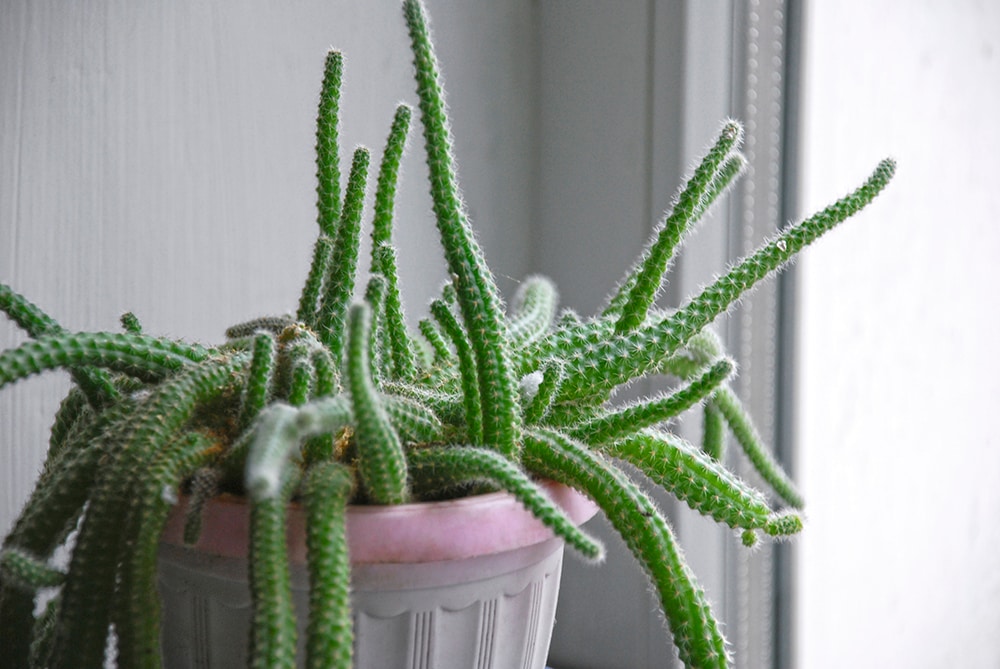
Low-maintenance, long-lasting, and aesthetically appealing, cacti can add an “exotic” touch to your garden. They grow both indoors and outdoors in harsh climates and poor soil. More importantly, these fascinating plants can survive in a desert for many weeks, if not months. So, if you’re noticing your cactus becoming squishy, it’s getting more water than it can handle.
Overwatering is a common mistake, especially when growing a cactus as a houseplant. That’s not the only thing that can make it fade and wither, though. Root rot, problems with drainage, and high humidity levels can also take a toll on this succulent plant. Want to learn more? Join us, and let’s check out the most common causes of a squishy cactus!
The 7 Possible Reasons Your Cactus is Squishy
1. You’re Giving It Too Much Water
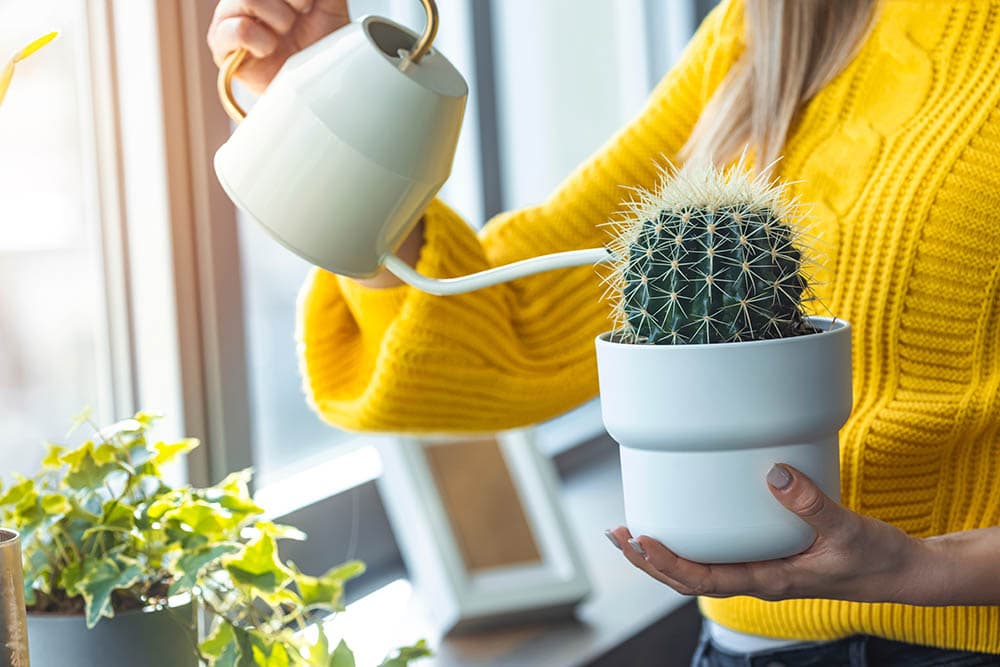
Is your cactus a bit mushy lately? Most likely, your watering habits are to blame here. Just like the vast majority of plants, cacti do rely heavily on moisture to grow and thrive. However, “domesticated” cacti generally suffer from overwatering instead of not getting enough water. As a species used to dry environments, they instantly become squishy in wet soil.
If this goes on for long, you’ll run the risk of killing both the roots and the plant(s). Cacti are succulents, which means they have the ability to store moisture in their stems and survive on that for weeks. So, when there’s too much “aqua” in the pot, that leads to a disaster, as they can’t absorb it adequately.
Stop watering the cactus for a while; give it time to recover. Use your fingers to determine the moisture levels in the soil: if the very top is dry, that’s your green light for adding some water. On average, you’d have to wait for 7–14 days for that to happen. Moving the pot to a spot near the window that gets lots of sunlight and air circulation will speed up the process. In any case, the name of the game here is patience.
2. Humidity Levels Are Off the Roof
The problem will not go away if you stop watering the cactus extensively, but the room is very humid. This is especially true for gardeners that live in the Southern states (Louisiana, Alabama, or Mississippi, to name a few). Cacti flourish in dry conditions and have a low tolerance for humidity. Many times, overly moisturized air leads to the plants getting infected or taken over by fungi.
Move the cactus to the driest room in your house. Placing it near the window that gets at least 3–4 hours of sun during the day could also fix the problem. Do keep in mind, though, that direct exposure to the sun for long hours might damage the plant. Some species can handle scorching sunlight, but most will suffer from it. And if that’s not an option for you, consider investing in a dehumidifier.
These devices come at a reasonable price and do a decent job of keeping moisture levels low. On top of that, change your watering routine: do it less often and in small “sips”.
3. The Drainage System Is Faulty
Are you growing cacti in pots? Then the first thing you should do is check on the drainage system. The less effective it is, the more time it will take for excess water to escape through the holes at the bottom, which—yep, you guessed it—will lead to a squishy cactus and rotten roots. These plants aren’t that fast to grow, but they do get bigger. So, most likely, the pot is just too small.
Or, the holes are clogged (possibly, by the roots), forcing the water to stay in the soil for longer. Sometimes, drainage trouble comes from keeping the cactus in an overly dark spot. While they don’t like to be burned by the sun 24/7, cacti do need bright light to function properly.
Start by transporting the plant to a bigger pot. In most cases, that will get the job done. Ideally, the drainage holes should be larger as well to prevent any potential problems in the future. Can’t seem to get your hands on a properly-sized pot right now? Try filling the old one with a drainage layer instead. We’re talking about adding gravel to the bottom of the pot that will absorb some of that water.
4. Root Rot Could Be the Problem
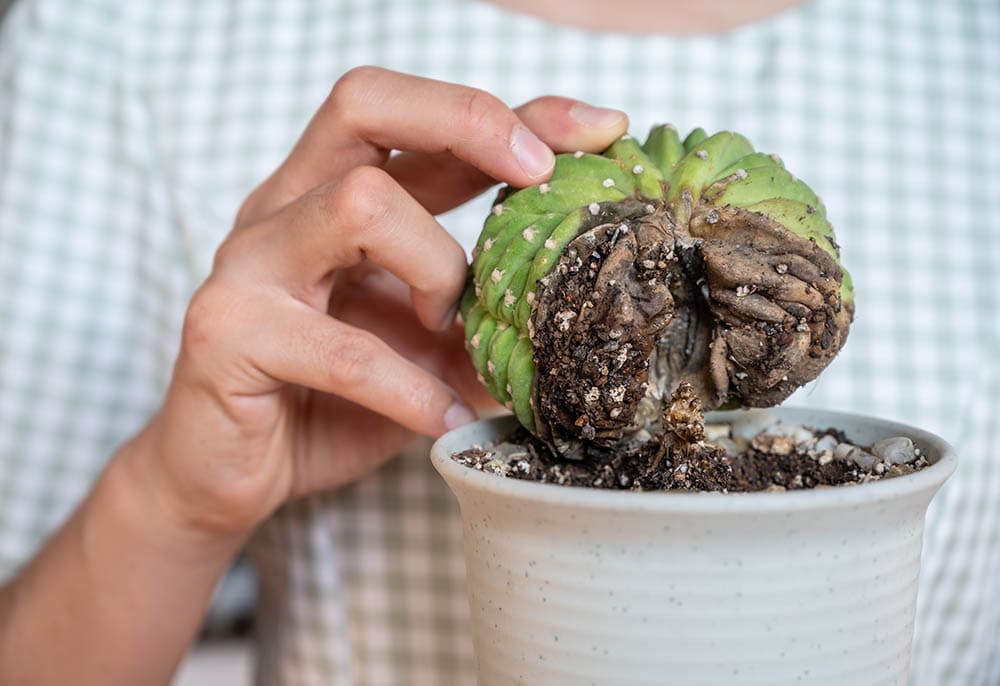
When the roots of a cactus are forced to grow in overly damp soil, they tend to rot. You’ll also notice the stems becoming way softer than they used to be. If not treated, root rot will eventually kill the entire plant. Remember: wet soil is the natural habitat for many bacteria and fungi, and it’s these pathogens that make the roots rot.
When the roots are damaged and can’t feed on the nutrients and the water properly, they wither away, and so does the cactus.
This might seem a bit harsh, but the only way to save the plant is to cut away all the damaged parts of the root system. Otherwise, the disease will spread. Do your best not to damage the healthy roots, though. Once you’re confident the disease is chopped off, consider moving the cactus to a new pot with brand-new soil to cultivate steady recovery.
Sometimes, the disease spreads from the roots to the plant. The remedy is the same here: get rid of any rotten parts that you see. When you’re done, don’t forget to sanitize the tool that you used for cutting (like a small knife or scissors). Otherwise, it might carry the bacteria/fungi to a different plant.
5. Check for Fungi and Bacteria
Unfortunately, root rot is not the only disease that cacti are vulnerable to. As mentioned, various bacteria and fungi prosper in water-rich soil. So, along with checking on the roots, watch out for black spots on the cactus. These are quite aggressive and quick to spread. Slow air circulation and dangerously high levels of humidity/overwatering—that’s what usually causes fungi. As for bacteria, they reproduce in dirty soil and water.
Before you grab the knife and get to cutting, try tackling the fungi or bacteria with pesticides. These biological organisms mixed with chemical compounds might prove to be useful against pathogens. They won’t cost you a lot but will last for quite some time. To be thorough, clean the pot with soap and hot water and boil the soil for 15 minutes. This will kill any traces of fungi/bacteria.
6. Maybe It’s Damaged Physically
Up until now, we’ve been focusing on overwatering and humidity and how that affects different parts of the cactus. However, if you’re watering it properly, there are no drainage problems, and the soil is nice and dry; the chances are the plant is squishy because of physical injuries. We’re talking about sunburn, damage from falling to the ground (like maybe your pet dropped it), and scale insects.
Mealybugs also like to “feast” on cactus flesh. While these injuries aren’t always lethal, they do make the plant weak against infections. Furthermore, it won’t be able to absorb all the right elements from the soil.
If you see signs of infection, use a bactericide or a fungicide like we talked about earlier. To make sure these pesticides won’t cause any harm, go with an organic compound, like neem oil. Other than that, there isn’t much to be done except for physically cutting out the injured and/or infected parts. A common mistake here is when you do nothing, hoping the cactus will heal itself.
That happens rarely; instead, the plant will die. So, disinfect the scissors or the knife, make precise cuts, move the pot to a bright, sunny, and dry area, and hope for a speedy recovery!
7. The Soil Is to Blame
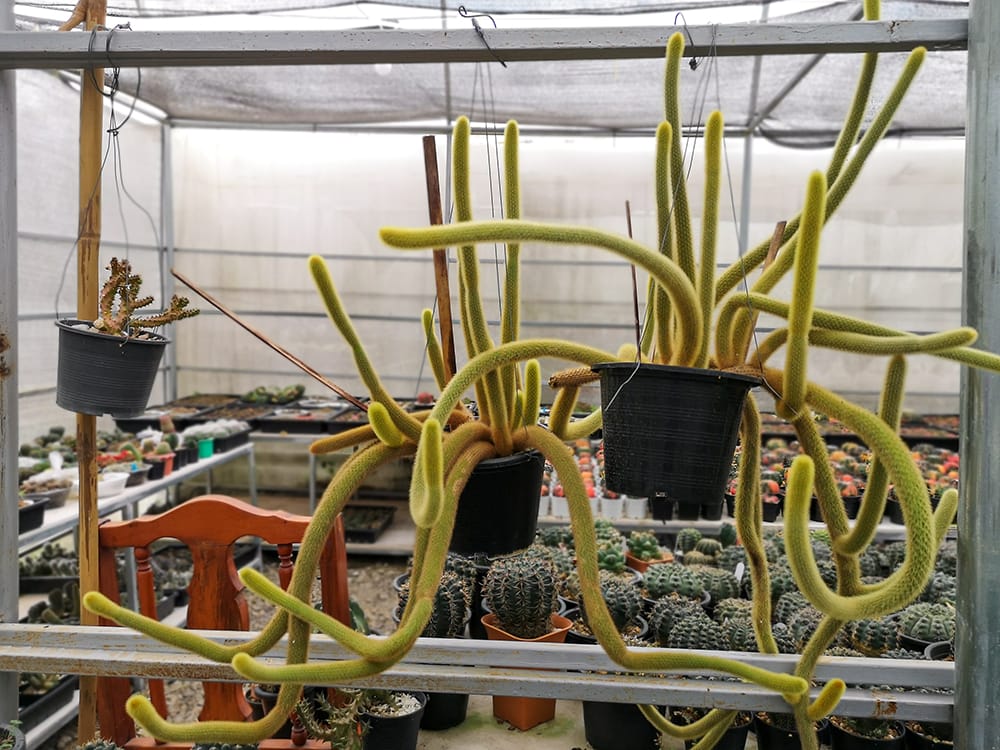
Light, airy, and quick-to-drain—that’s the type of soil cacti prefer. If it’s heavy and overwhelmed with different fertilizer products, these plants will get squishy rather quickly. Furthermore, if you’re using the wrong potting mix, it might disrupt drainage, leading to root rot. That’s right: while cactus plants can grow in challenging conditions, you still need to be careful and conscious about the soil that you plant them in.
As for fertilizing, only do that once a year (in mid-spring or early summer). If you fertilize the soil once a month, that will make the cactus fade.
There’s a very simple (and relatively cheap) solution: only buy a cactus soil mix for your spiky plant—that’s pretty much it! It will be specifically formulated and mixed to be healthy for cacti and stimulate rapid growth. Now, while certain brands come at a steep price, most cactus-special mixes aren’t at all expensive and do a decent job of keeping both the roots and the plant healthy.
If it says “for succulent plants” on the tag, you can buy it. Go for a 25% perlite and 75% substrate mix.
 What Is a Cactus? The Definition
What Is a Cactus? The Definition
Thick stems, pointy spikes, and various shades of green: that’s what instantly pops in our heads when we’re asked about a cactus. Often mistaken for a tree, it is, in fact, a succulent plant—a perennial. It’s very easy to recognize a cactus when you see one: the scales/spines make it immediately stand out among the more common plants with leaves. With that said, cacti come in all shapes and sizes.
They can be red, pink, or yellow, and look more like flowers than anything else. Overall, there are more than 2000 cactus species out there, and most of them grow in deserts. Oh, and there are lots of native species in the Americas, including the US and Canada. We bet you’ve seen the big, spiky saguaro cactus more than once on the big screen. Well, it’s an Arizona breed.
Do You Grow It Indoors or Outdoors?
The best thing about cacti—they can flourish in the toughest environments. And yes, you can grow them as houseplants just as easily as cultivating them in your outdoor garden. Different species are best suited for different temperatures, light exposure, and soil, though. So, before you buy a cactus species (or order it online), take a minute or two to check the tag.
It will have info on watering, fertilizing, pruning, and more. This way, you’ll be able to get a plant that thrives indoors/outdoors with minimal effort on your side. Now, since most of us like to use our cacti as houseplants, here’s a quick look at the nine best species to grow at home:
- Christmas cactus
- Bunny ears cactus
- Golden barrel cactus
- Rat Tail cactus
- Old lady cactus
- Star cactus
- African Milk Tree
- Bishop’s cap
- Saguaro
How Long Do Cacti Last?
Every single species is unique and has its own lifespan. If we take cacti in general, they last for 10–200 years. The Saguaro cactus is the longest-living species (150–200 years), while the Barrel cactus only lasts for 50+ years. The important thing to remember here is that most cactus types usually live longer when grown outdoors.
But, if you follow the tips from our guide and take proper care of the plant, it will survive for many years, if not decades. On average, indoor cacti go on for 8–10 years, which is a very decent lifespan—even for a perennial. However, as they reach the end of their lifecycle, all the scratches, scars, and injuries linger. Please keep this in mind when planning on growing a cactus as a houseplant.
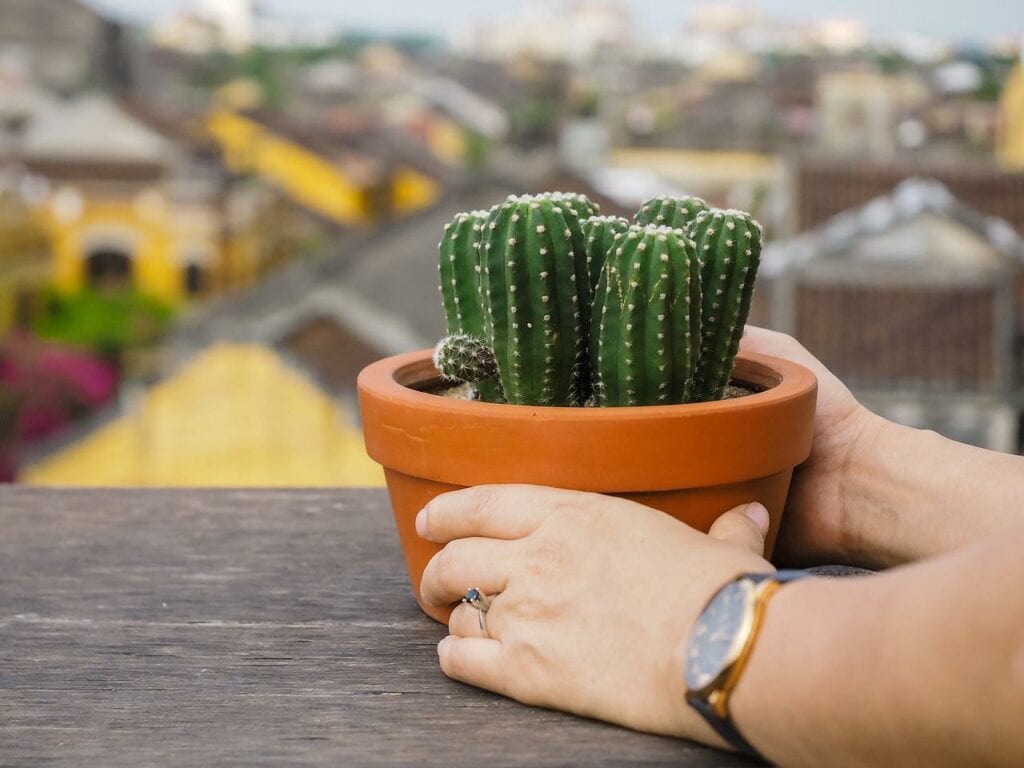
Are Cacti Healthy?
In South America, cacti are cooked, squeezed for the refreshing juice, and eaten raw. On top of being tasty, cacti are quite nutritious and healthy. The pads and the actual fruits are a natural remedy against a wide range of infections. For example, if you’re suffering from a bad hangover, cactus juice will get you back on your feet, curing weakness, headaches, nausea, and anxiety.
And if you include cacti in your diet, it will help reduce body fat, normalize blood pressure, lower the risk of strokes, and keep cholesterol levels down. These magnificent plants are rich in iron, omega 3, cooper, and calcium, along with vitamins A, E, and C. So, yes, cacti are a mighty source of nutrients. They will lose some of those precious vitamins when fried or mixed with other ingredients, though.
Conclusion
Rough, tough, and easy to grow, the cactus is a go-to choice for many households across the US. Sadly, most of us tend to add way too much water to cactus pots, making them weak, squishy, and slowing down growth. Diseases, pests, and poor drainage can also suck the life out of an otherwise perfectly healthy cactus. On the bright side, it doesn’t take a lot of effort to fix this.
It’s all about maintenance. If you check on your cactus often, pick the right soil for it, follow tried-and-true instructions carefully, and readily cut out rotten roots, you’ll be able to eradicate squishiness for good and ensure a prosperous life for your green and spiky plant!
- Gov – Saguaro Cactus
- Britannica – The Cactus Plant
- WebMD – Health Benefits of Cactus
- Root Rots on Houseplants
- 7 Best Types of Cactus to Grow Indoors
- 8 Best Cactus Varieties to Grow Indoors
- How Long Does An Indoor Cactus Live?
- SmartGarden – How Long Do Cacti Live?
- Why Is My Cactus Going Soft? (Great Tips To Avoid That)
- Why Is My Cactus Squishy? How to Save A Rotting Cactus
- GardensWhisper – Why Is My Cactus Squishy?
- Cactus Problems: Why Is My Cactus Going Soft
- You may also be interested in: How and When to Plant Hollyhock Seeds? What You Need To Know!
Featured Image Credit: KawaiiS, Shutterstock
Contents


